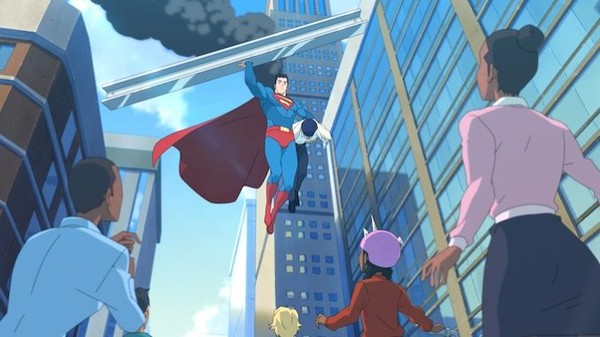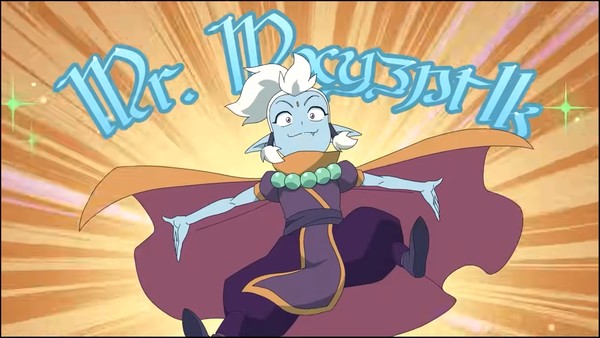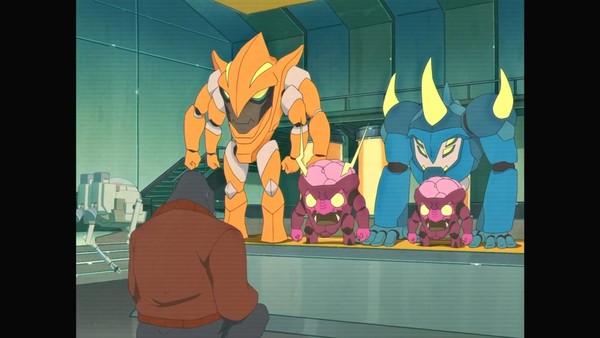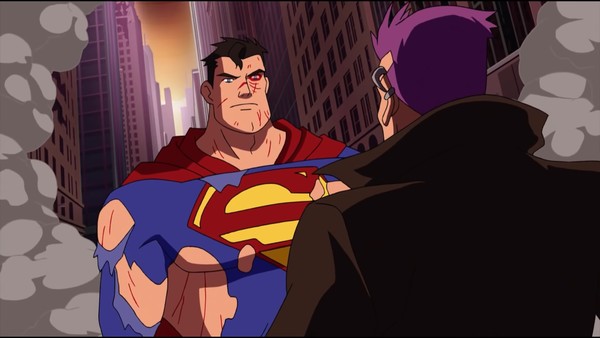How Anime Helped Save Superman
by ZeroReq011,Besides enjoying anime, I grew up watching Bruce Timm's Superman. From watching his Superman: The Animated Series and Justice League cartoons, Superman became the superhero with the biggest guns, the biggest shield, and the biggest heart. I was a bigger Batman fan at the time, but that didn't stop me from thinking about his words and his deeds. His comrades would call him their best hitter, while he would call himself their shield. He takes more blows so that others don't have to, and while those blows aren't normally as dangerous to him, they can still hurt a lot.

That care for others extends not just to his colleagues and loved ones, but to everyone. From villains causing doomsday to cats stuck in trees, he'll rush down to assist people, no matter the trouble. He'll take the time to pause his search for the people trying to hunt him to help reunite a lost girl with her mom. Despite technically not being from Earth or biologically even human, the superman Clark Kent grows up to be while raised by the Kents is proof in his story of a humanity that also exists in the positive abstract: love, charity, and kindness towards one's fellow American, human, and person.
That turned him into an icon, though recently, we've been treated less often to a friendly Superman that walks with people and more to an angsty Superman that hovers over them. It's not like Superman stories haven't been done more grimly and grittily before in comics, but his latest box office incarnation by Zack Snyder – detached and self-absorbed – has been Superman's most visible mainstream depiction in the past decade. A Superman informed by deific duty without human kindness, artistic freedoms aside, goes against the good Superman has long represented to people.

Greenlit before Snyder stepped down from directing DC movies and released post-Snyder, My Adventures with Superman features a Superman that's decidedly less dark, more down-to-earth, and… more anime, or at least anime-inspired. It would be a bit much to give most of the credit for the new Superman direction to anime, as the show is as much returning Superman to form as it is updating Superman to the current times. However, I'd like to argue that anime influences don't simply stop at looks and references.
My Adventures with Superman – Anime References
Let's first discuss the more obvious anime elements anyway. My Adventures with Superman was animated by South Korean Studio Mir, whose staff before Mir's establishment previously worked on the anime-inspired Avatar: The Last Airbender before producing the similarly anime-influenced The Legend of Korra and Voltron: Legendary Defenders. In an interview, co-writing creator Josie Campbell directly admitted to the show's anime influences: "There's a lot of anime that influenced us… Sailor Moon, yes, there's a little magical girl. Dragon Ball, we talked about that a lot. We talked about Neon Genesis Evangelion and Gundam. Some of it is in the way things look. Some of it is in the titles having little references and Easter egg shoutouts to anime."


All the aforementioned anime in the interview and more are referenced in the show. Clark receiving his superhero suit in Episode 2 calls back to magical transformation sequences in Sailor Moon and other magical girl shows. The camera pans on different portions of Superman's body being wrapped in an undefined blue energy before it materializes into parts of his iconic blue costume.

Interdimensional trickster chaos-being Mr. Mxyzptlk in Episode 7 is re-imagined design-wise to look like the inhuman otherworldly demons and deities of Dragonball Z. The same episode is titled "Kiss Kiss Fall in a Portal," a reference to the memorable first line of Ouran High School Host Club's OP "Sakura Kiss," and a fitting name for an episode centered around Clark and Lois Lane's budding romance… and portals.

The least subtle anime reference is in Episode 6. Monsieur Mallah and the Brain raised for self-defense look unmistakably like the uniquely and cartoonishly designed gunmen mechs of Gurren Lagann, with faces so large that they cover over the entirety of their stubby torsos and make up most of the mechs' appearances.


While giant military robots bring Gundam to mind, the angular "heads," triangular "chests," thin "waists," and jagged "shoulders" introduced at the show's beginning also draw, appearance-wise, from the mechs of Evangelion. The Evangelion influences in Episode 3's new supervillain origins for Tech Bro Ivo and Parasite demonstrate an even closer resemblance, especially given the parasite suit's need to biologically interface with its user (Eva units are both mechanical and organic constructs) and the predatorial bestial look it takes on when the suit is powered up (Eva units resemble wild beasts when they go out of control or have their berserk modes activated). With the power of an entire city behind it, the parasite suit mutates into a giant monster or kaiju the size of skyscrapers, like Godzilla.
My Adventures with Superman – Anime Storytelling
With anime references and aesthetics out of the way, let's discuss possible anime shojo and shonen storytelling influences. Rather than true genres, shojo and shonen refer to a story's marketing-targeted gender demographics (shojo for girls, shonen for boys). Arguments about genre or demographics aside, shojo and shonen stories tend to develop characters in distinct ways, the details of which I'll discuss. To caveat though, stories designated shojo or shonen don't all neatly fall into one gendered character approach over another, and many stories mix story elements associated with both demographics, especially nowadays. Regardless, these terms remain useful for analyzing narratives.

Besides being aesthetically feminine, shojo stories are traditionally more expressive and open to exploring and interrogating character emotions and relationships. Shojo series will typically dedicate significant time and space for its usually female (but also male) characters to ruminate over how they and others feel in response to development, before vocalizing or asking others to vocalize those feelings at a later point. In shojo romances, those introspections and confessions take on a more romantic character: "What do I think of them? What do they think of me? Why do I feel this way? Why do they feel the same about me?" and so on.
Besides being aesthetically masculine, shonen stories are traditionally more instrumental and geared toward encouraging their characters to act towards or against something. Shonen series will typically dedicate their efforts to portraying its usually (but not exclusively) male characters as working towards or thinking about how to achieve something. Shonen series won't necessarily omit characters expressing their emotions, but they usually won't directly dwell on them for too long either and will defer to acting over monologuing as an outlet for their feelings. With romances in shonen, characters (especially males) will concentrate more on doing things for love interests than describing their feelings for them.
Traditional shojo magical girl stories provide more action-active roles for female protagonists by making them fighters for others and against evil while still emphasizing their femininity. Their plot premises usually center around an ordinary girl first acquiring magical powers and then subsequently trying to balance their everyday mundane life with their fantastical fighting side.
Traditionally, shonen battlers not only give their protagonists opponents to battle against; they also structure their plots around protagonists starting weak(er) in strength and character before building both aspects up through training and fighting. Their character arcs unfold and progress as their abilities expand and sharpen.

Using these Japanese terms, Superman stories would generally fall under the shonen umbrella, though My Adventures with Superman also has strong shojo elements. Putting references aside to focus on deeper narrative comparisons, Superman and the magical girls are battle-ready protagonists who must balance their heroic sides with their mundane ones.
Unlike previous Superman origin stories where he arrives in Metropolis knowing all about his Kryptonian origins and already able to use all his powers, this Superman arrives with no idea about Krypton and without all his abilities, closer to the shonen battler model. As he helps people and fights supervillains, he unlocks his customary powers while acquiring knowledge about himself and Krypton.
My Adventures with Superman is very shonen with all its throwing and hitting, but it's also romance-heavy in a very shojo way. From its title, the show is just as much about other people like Lois as it is about Superman. Compared to many anime romances and superhero cartoons, both notorious for being slow and teasing about their couple hookups (if any hooked up in the end), the speed at which Clark and Lois get together is quick yet natural. Lois is a cute tomboy, and Clark is a country beefcake. They're physically attracted to each other and develop an easy romantic chemistry. Ultimately though, what brings their romance together is the two of them openly communicating why they like each other. Almost tragically, what nearly broke their relationship apart before this development was not communicating openly enough. However, shonen approaches to romance aren't absent in the show. Clark picks up coffee and flowers for Lois and shields her from a bullet laser turret. Lois encourages Clark to be more of an aggressive reporter through her example, and she's the more forward partner of the two.
Superman is a Symbol
I've discussed anime references and storytelling influences in My Adventures with Superman, but the title of the article isn't "Anime Influences in the New Superman Show." It's "How Anime Helped Save Superman." The show isn't just an Easter egg hunt for anime fans, nor is it just a more anime retelling of the world's most famous superhero. By drawing from anime superhero stories, My Adventures with Superman injects into the larger Superman canon a renewed faith in the altruistic goodness of superheroes that Japan continues to hold, and the West lost for a while in theaters with Snyder.
I might be poking the Snyder fan bear with a stick on this. I'm not the first to criticize Snyder's Superman, so I'll try to get ahead of some potential criticism.

Snyder's Superman has been defended by his fans as a brilliant case of dark deconstruction. To be clear, I'm not against dark stories. I'm a fan of Gen Urobuchi, the "Urobutcher." I'm not against genre deconstruction, either. I'm a super fan of Urobuchi's Madoka Magica, an example of magical girl genre deconstruction. Like old proteins broken down into their amino acids before being reformed into new proteins, deconstructions are a storytelling approach authors can use to challenge existing conventions and assumptions of given tropes or genres to the point of taking them apart, upon which they can then create new interpretative possibilities for those tropes and genres using the ripped-out parts.
But from how I understand things, the larger frustration over how the Man of Steel has been portrayed in Snyder's Man of Steel and Batman vs Superman isn't really because there are Superman stand-in characters that are being portrayed more cynically. The Boys' Homelander and Invincible's Omniman are critically-acclaimed examples of perverse supermen. It's the fact that it's Superman himself being portrayed with near unrelenting cynicism in Hollywood blockbusters – as a definitive Superman for the casual superhero movie-goers and first-time Superman viewers of today – that's the issue. Leaning on deconstruction logic to argue creators should be free to re-imagine any character they see fit without criticism neglects the effect debasing icons like Superman has on society. He is more than a character.

Superman is a symbol, a model for humanity that his earlier creators wanted audiences to aspire to.
Superman is a person who, despite his alien origins, is a down-to-earth guy whose strength is only matched by his kindness to others. He was raised human, fell in love with humanity, and fights for humanity embodying its best qualities, all based on what he's personally experienced of human goodness through the Kents. Superman isn't "Superman" because he's above humans. He represents the best of them. He inspires audiences to be better people. Out of all the things to not just question but undermine, why would you delegitimize a good thing like that?
Because it's naïve and we shouldn't tell lies? Because being a hypocrite is worse than being a chump?
Even before Snyder, Superman's core characterization has faced criticism before for being naïvely out-of-touch, his aims at achieving a better, kinder, and just world an unrealistic dream – never mind Superman first coming to print the year before America entered WWII.

To those criticisms is a quote by Superman in Superman vs. The Elite: "Dreams save us. Dreams lift us and transform us into something better. And on my soul, I swear that my dream of a world where dignity, honor, and justice are the reality we all share, I'll never stop fighting. Ever."
Anime Helps Save Superman

Japan has been keeping up the good fight, even while it's also been dealing with its own growing societal cynicism, and even when its favorite Western superhero is Spiderman. Kōhei Horikoshi's popular Japanese superhero franchise My Hero Academia is influenced by Spiderman, but other American superheroes like Captain America and Superman also influence it. All Might is often depicted like classic Superman artworks, with light and shadow accentuating his burly features and smile. His smile serves to be just as iconic in the My Hero Academia universe as the "S" is in Superman's, second only to his Superman-esque ideals and third to his habit of naming his fighting moves "Smash" after an American state.
Like many versions of Superman before, All Might knows his personage's cultural impact on his society. It influences folks in general to be kinder and fairer. It encourages people with power to use those abilities for good over self-gain. It inspires people to become heroes like him, not in his abilities but in his beliefs to help others no matter the trouble – inspiring Deku, who risked his life to help despite not being born with superpowers. Similar to Superman in stories like Superman vs. the Elite, All Might saw more superheroes giving in to ego, celebrity, and self-interest and more of the public regarding superheroes cynically. He sees that, and concludes his ideals are more relevant and urgent than ever. However diminished his image has become after his superhero prime, whether his image of the goodliest superhero will continue to hold any power at all rests on his will to continue giving it his all his might and more without compromising. Even if he can't take the blows as well as the Superman he's inspired by, one way or another, he'll keep fighting and never stop.

While not strictly fitting Western molds, Japanese media has had its crop of homegrown superheroes that follow the same basic principles that Superman does: helping others. You got your giant mech pilots, magical girls, superpowered astro androids, superstrength cyborgs, super sentai rangers, masked kamen riders, Ultraman aliens, and a cackling gold skull-man named Golden Bat. But like Western superhero stories and heavily Western superhero-influenced anime like My Hero Academia, Japan's original superhero narratives have been affected by a similar curtain of cynicism, part of a larger wave of pessimism that's been attacking established societal beliefs and authorities. No anime covers that as well as Concrete Revolutio, the Watchmen of superhero anime.
Concrete Revolutio's full title is "Concrete Revolutio: Superhuman Phantasmagoria," and "phantasmagoria" according to Oxford Reference is "a fantastic or dreamlike sequence of real or imagined images," very in keeping with the show's themes. Following Jiro Hitoyoshi and a public agency of superheroes whose task is watching over other superhuman beings, ostensibly to "protect them," the story soon makes it clear how much that goal comes into conflict with the established authorities' more insidious aims to "control them" if they can and "eliminate them" if they can't or if it's more convenient. Jiro is an idealist who passionately believes that superheroes with ideals like Superman are real and forces for good, but is frustrated in so many ways by the political machinations of a government body that's too afraid of superhumans to let them act freely, if at all, and the smug cynicism of a media system that thinks superheroes are just immature fantasies that are only worth profiting over.

In the face of the cynicism of the times, Jiro fights.
In the face of the cynicism of the times, All Might continues to fight.
In the face of the cynicism of the times, Superman must continue to fight the good fight.
They continue to fight, and they must, because they and their creators believe a better, kinder, more just world is possible if they do. They believe in it because they believe in the goodness of people. As long as they continue to fight, then it's possible that people will continue to believe in them and that good fight. That world will continue to be possible. Superheroes like or even greater than them might rise to join the battle, and if someday they take too many blows and fall, they can rest assured that others can take their place to carry on the human dream for lasting peace. Other superheroes and us. Anime still believes in the altruistic goodness of superheroes, and while it's a bit much to claim anime saved Superman, I'd like to believe through My Adventures with Superman that anime helped.
Social Scientist & History Buff. Dabbles in Creative Writing and anime Criticism. Consider checking out his blog, Therefore It Is.
discuss this in the forum (33 posts) |